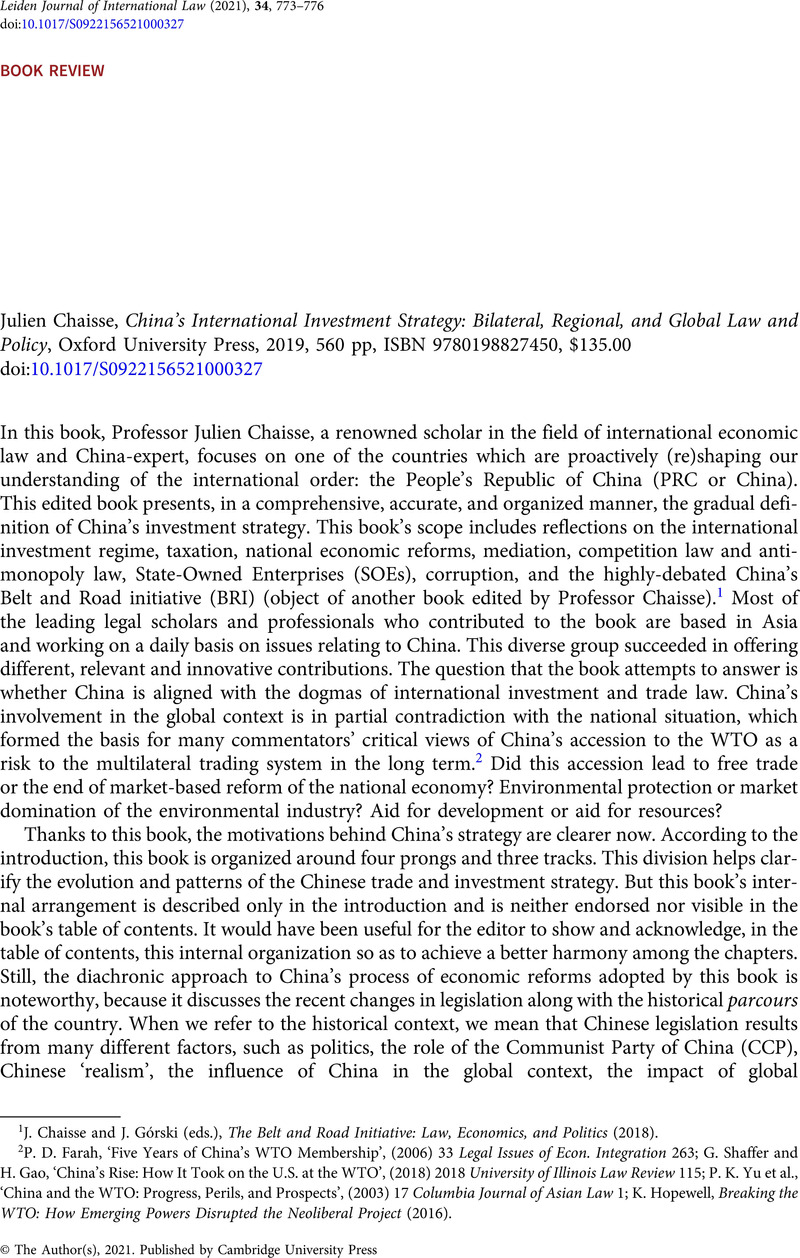No CrossRef data available.
Published online by Cambridge University Press: 08 June 2021

Associate Professor, West Virginia University, Eberly College of Arts and Sciences, John D. Rockefeller IV School of Policy and Politics, Department of Public Administration; West Virginia University, Center for Innovation in Gas Research and Utilization - CIGRU; West Virginia University, Institute of Water Security and Science – IWSS (USA). Founder, President, Director, Principal Investigator and Senior Research Fellow at gLAWcal—Global Law Initiatives for Sustainable Development. Internationally Renowned Professor/Distinguished Professor of Law at Beijing Foreign Studies University (BFSU), Law School, Beijing, China. Dual PhD in International Law from Aix-Marseille University (France) and University of Milan (Italy), LLM in European Legal Studies from the College of Europe in Bruges (Belgium), Maitrise (J.D.) in International and European Law from Paris Ouest La Defense Nanterre University (France) [paolofarah@yahoo.com; paolo.farah@glawcal.org.uk].
1 J. Chaisse and J. Górski (eds.), The Belt and Road Initiative: Law, Economics, and Politics (2018).
2 P. D. Farah, ‘Five Years of China’s WTO Membership’, (2006) 33 Legal Issues of Econ. Integration 263; G. Shaffer and H. Gao, ‘China’s Rise: How It Took on the U.S. at the WTO’, (2018) 2018 University of Illinois Law Review 115; P. K. Yu et al., ‘China and the WTO: Progress, Perils, and Prospects’, (2003) 17 Columbia Journal of Asian Law 1; K. Hopewell, Breaking the WTO: How Emerging Powers Disrupted the Neoliberal Project (2016).
3 A. Hu, ‘The Distinctive Transition of China’s Five-Year Plans’, (2013) 39 Modern China 629; Y. Wu, X. Zhu and N. Groenewold, ‘The Determinants and Effectiveness of Industrial Policy in China: A Study Based on Five-Year Plans’, (2019) 53 China Economic Review 225.
4 J. Chaisse (ed.), China’s International Investment Strategy: Bilateral, Regional, and Global Law and Policy (2019), at 3: ‘China’s major motivating force in subsequently contracting IIAs has been to strike a balance between investor protection and the government’s power to regulate’.
5 P. Farah and E. Cima (eds.), China’s Influence on Non-Trade Concerns in International Economic Law (2016).
6 Chaisse, supra note 4, at 28, 40, 47.
7 J. Blanchette, ‘Against Atrophy: Party Organizations in Private Firms’, Made in China Journal, 18 April 2019, available at madeinchinajournal.com/2019/04/18/against-atrophy-party-organisations-in-private-firms/.
8 Chaisse, supra note 4, at 23–41.
9 Ibid., at 41–56.
10 Ibid., at 66, ‘Chinese experience demonstrates that tax factors are used extensively by the Chinese government in both attracting FDIs into China as well as relieving tax disadvantages of Chinese outbound investment.’
11 XINHUA, ‘China’s Central SOEs Participate in Belt and Road Development’, xinhuanet, 30 October 2018, available at www.xinhuanet.com/english/2018-10/30/c_137569889.htm.
12 Chaisse, supra note 4, at 377.
13 Ibid., at 11, 70.
14 Ibid., at. 200.
15 Contra see ibid., at 86 (‘the state should in principle provide an open and non-discriminatory environment to foreign investors and investments, regardless of their ownership structure’).
16 Ibid., at 204 (‘As far as the rules are concerned, China is not ready, and Chinese SOEs are not ready. But deep inside, China and Chinese SOEs need clear signals and policies which are headed in the right direction but have not yet appeared. If both sides want this great and important treaty to come to a conclusion, both sides need to be more constructive and make concessions, especially the US side, by introducing more tolerance and patience’).
17 Ibid., at 54.
18 Ibid., at 111.
19 Ibid., 320.
20 Farah, supra note 2, at 263.
21 Chaisse, supra note 4, at 253.
22 Ibid., at 138 (‘Canada also failed to rein in obligations concerning preferential treatment of SOEs, beyond that of a SOE exercising governmental authority delegated to it. The particulars of the relationship, such as the degree of control and influence between the SOE and state is left untended’).
23 Ibid., at 142 (‘Our findings, pointing to scientific and technological innovation as an important explanatory variable in China’s new investment approach, are not confined to the China– Israel relationship’).
24 Ibid., at 305.
25 National Development and Reform Commission, Ministry of Foreign Affairs, and Ministry of Commerce of the People’s Republic of China, ‘Vision and Actions on Jointly Building Silk Road Economic Belt and 21st-Century Maritime Silk Road’, Belt and Road Portal, 30 March 2015, available at eng.yidaiyilu.gov.cn/qwyw/qwfb/1084.htm (‘Countries along the Belt and Road should … work to ensure that the WTO Trade Facilitation Agreement takes effect and is implemented’).
26 Chaisse, supra note 4, at 223.
27 Ibid., at 253.
28 For the possibility of using the ISDS to enforce the Antimonopoly law see ibid., at 493–504.
29 Ibid., at 509.
30 Mao Zedong is not even quoted in the book and the CCP is referred at only in a limited part of the book.
31 S. Heilmann and E. J. Perry (eds.), Mao’s Invisible Hand: The Political Foundations of Adaptive Governance in China (2011); B. L. Liebman and C. J. Milhaupt (eds.), Regulating the Visible Hand? The Institutional Implications of Chinese State Capitalism (2016).